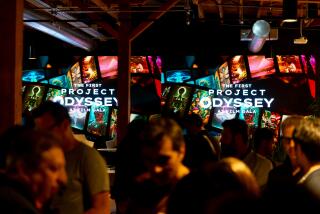Students Bring Lessons to Life With I-Movies
- Share via
Fifth-grade teacher Max Schafer’s class at Fenton Avenue Charter School in Lake View Terrace has become a mini-film school.
But instead of shooting ghost stories, adventures or romances, the students are producing, directing and acting in computerized videos about math, science, vocabulary and other educational topics. These I-movies (Internet movies), produced and edited on a program in classroom computers, are an increasingly popular tool at schools in California and nationwide.
Schafer’s students, for example, recently began creating a science movie about the solar system that features Styrofoam planets and narratives about rotation around the sun.
Besides mastering new technologies on cameras and software and giving students a sense of independence, the I-movie process teaches them the subjects themselves, Schafer said. Students become motivated to learn about science when creative expression and artistry are involved, he added.
“It’s really fun. I love learning something new,” said a fifth-grade camera operator, Ashley Hernandez.
Schafer explained that the I-movies, usually 20 to 30 minutes long, do not replace exams or term papers. “Writing skills are too important at early grades to cut back. But enhancing their writing with pictures, sounds and video really develops deeper understanding of the subject.”
Such technology has been embraced by more and more schools, according to Milton Chen, director of the George Lucas Educational Foundation, a San Rafael-based foundation started by the “Star Wars” creator to promote video and computer advances in K-12 classes. Multimedia projects like I-movies, Chen said, help “students develop the ability to work together in groups and develop self-knowledge as well.”
Making I-movies is a relatively easy multimedia process. The footage shot in Schafer’s class with a digital video camera includes pictures of planets found on the Internet. After the tape is copied to the computer, I-movie software is used to produce an edited product that can be copied to video or burned onto a disc. “What’s really nice is that you can put it on a CD to give to parents, so that they can see what’s going on in the classroom,” said Schafer.
I-movie software comes with the Macintosh computers that the charter school, sponsored by the Los Angeles Unified School District, has purchased for every fourth- and fifth-grader with district funds and grants.
The students approach the projects seriously. For instance, fifth-grade movie director Marielle Ordono told students to “take two” when they didn’t speak loud enough or had trouble reciting their lines, or when props were not arranged correctly. Marielle was ultimately happy with the final product about outer space and enjoyed being in charge. “I liked telling them what to do,” she said.
Last year, Schafer’s class created a math I-movie. Student actors used props such as baseballs and milk cartons to demonstrate math principles, such as measurement.
Schafer’s fifth-grade students worked on a project last year based on “Theater Games,” the book of acting exercises by Voila Spolin. Teachers were sometimes uncertain about how to demonstrate the games to the students after reading the book. “So we thought, ‘Hey, why not put this on CD and show video-clip examples of how to play the games,’ ” Schafer said. The I-movie featured students enthusiastically doing improvisation acting, such as playing “tug of war” without a rope.
Fenton Charter students soon will be working on an I-movie in which they will visually act out vocabulary words that may be difficult for students, particularly those with limited English skills.
Although L.A. Unified does not keep a list of how many schools are active in I-movie production, the district has installed 35,000 multimedia computers equipped with the program for students to create I-movies, according to Jim Konantz, information assistant superintendent for the district. “The students do independent research to make the movies. They really get involved,” he said.
Similar enthusiasm has been shown in other districts around California and elsewhere.
For example, in Atherton in Northern California, Menlo Middle School students have created various I-movies, including a 10-minute “electronic scrapbook” based on the eighth-graders’ trip to Washington, D.C. “They have scanned images from brochures, museum tickets and photos. Added music, text and their own voices,” said Nancy Fortman, the school’s technology director.
She was pleased with the process and results. “I believe that one of the most important skills students need is the ability to communicate. Today’s technology allows for students to create a story, use still pictures or moving video, sound and text to tell their stories with I-movie,” Fortman said.
In the Los Angeles area, Consuela Molina, a senior last year at San Fernando High School, made a documentary-style I-movie for her social studies class about sweatshops and women workers in Indonesia, Mexico and the Los Angeles area. Molina, now a student at UCLA, posted it on the Web, where it was seen by a teacher in India, the Women’s Human Rights Conference in Paris and students in Australia, according to her high school social studies teacher Marco Torres.
San Fernando students have made more lighthearted films too, such as a recent Christmas movie about a snowman in a snow fight with elves.
The research and script writing for I-movies, Torres said, sometimes can take the place of writing term papers.
Torres explained that scripts are often more clearly and concisely written than term papers because students are more actively involved in choosing materials.
“I see kids who don’t traditionally do well in school succeed because this was another way for them to express themselves,” said Torres.






